How To Write a Reference

If you’ve been asked to provide a reference for a former employee, you might not know where to begin. To help, we’ve put together everything you need to know on how to write a reference letter as well as an employee reference template to make things even easier.
Take the stress out of onboarding and offboarding with Personio.
Key Takeaways
A job reference is an endorsement of an employee’s skills, character and achievements for potential new employers.
You can decline providing a reference if you do not feel you’ll be able to provide a positive one or do not know enough about the candidate.
If you do agree to write a reference for an employee, legally it must be honest, fair and accurate.
Contents
- 1What Is a Job Reference?
- 2Are There Different Types of References?
- 3Preparing To Write A Job Reference
- 4Key Points To Include in a Reference
- 55 Steps To Write A Great Reference Letter
- 6Employee Reference Template
- 7Best Practices for Writing Job References
- 8Frequently Asked Questions
- 9Job References Don’t Have To Be Difficult
What Is a Job Reference?
A job reference, or letter of recommendation, provides information about a former employee to their potential new employer, detailing their skills, attitude and other characteristics. It can be a basic summary of how the employee performed or a more detailed account of what the recruiter can expect if they decide to hire them.
Typically, a reference is a positive recommendation that helps the individual get a new job. If you are approached for a reference and you think you’ll be unable to provide a positive one, it’s okay to decline. You can provide a negative reference, but legally it must be ‘fair and accurate’ as candidates can dispute a reference they deem to be unfair.
Are There Different Types of References?
While we focus on employee references, there are three main types of references:
1. Professional Reference
A professional reference provides information about a candidate in a work setting and is usually written by their former manager, supervisor or colleague. It provides an honest overview of the candidate’s skills and characteristics that make them a good employee. It should also include the amount of time spent at the company, their responsibilities and any achievements within the role.
2. Character Reference
A character reference is more personal and is often used when the candidate doesn’t have any work experience or if it’s been a while since they were last employed. It is usually written by a family friend, neighbour or other source that knows the candidate well enough to discuss their personal traits and qualities that would help in the workplace.
3. Academic Reference
An academic reference details a candidate’s educational background and is written by a former teacher, lecturer or mentor. It should confirm any claims made about the candidate’s education, as well as provide information on any academic achievements that will increase the chances of the candidate being hired.
Preparing To Write A Job Reference
Before you agree to write a personal reference, make sure you know enough about the candidate to provide a truthful recommendation.
After all, you may not know them well enough to vouch for them or remember much about them if it’s been a while since they worked for you. If you have any doubts, it’s always better to politely decline and offer an alternative contact they can approach.
If you’re happy to proceed, it’s a good idea to refresh your memory of the candidate. Dive into your HR records for help or look back at your own notes from appraisals to see if there’s anything useful.
If any specific examples spring to mind, be sure to include these to provide a realistic picture of the candidate. Remember you’re trying to help them, so anything positive you can include will go a long way.
Key Points To Include in a Reference
Now you’re ready to write a personal reference, here are the key details to include:
Job title
Salary
Your relationship to the candidate
Length of employment
Roles and responsibilities
Strengths and achievements
Professional conduct
Examples of good performance
Why the candidate left
Find out how to build a great reference check process today.
5 Steps To Write A Great Reference Letter
A personal reference should be long enough to provide enough detail about the candidate, but concise enough to convey the key points clearly.
Be sure to use business letter format and a legible font, so it can be read easily. With the details of what to include in mind, here’s how to write a reference for an employee:
1. Greeting
As this is a professional document, start the letter using business format. If you know the recipient’s name, address the letter to them directly. If you don’t, use a formal greeting such as ‘Dear Sir/Madam’ or ‘To whom it may concern’.
2. Introduction
Give a brief introduction about yourself and explain your relationship to the candidate. Keep it short, but be sure to include how you know them and why you’re qualified to write this reference for them. Remember to include where you worked together and for how long.
3. Body
The main body of the letter should focus on the candidate and include all the key points mentioned above. Split the text into paragraphs, so it’s easily digestible. Try to include relevant examples throughout to show why they’re qualified for this new role.
4. Closing
End the reference letter on a positive note, expressing your willingness to provide more information if required and give your contact details. You can also take this moment to reiterate why you would recommend the candidate.
5. Signature
Following the business letter format, you should end with ‘Yours sincerely’ if you know the name of the recipient or ‘Yours faithfully’ if you do not. Sign the letter with a handwritten signature, if you can, or simply type out your name if it is an email.
Attract More Qualified Candidates, More Quickly

Sourcing talent with Personio has never been simpler, with access to 500+ job portals to spread your job advert far and wide. Click the button below to see how it looks in action.
Source Top Talent With PersonioEmployee Reference Template
Looking for more guidance on how to write a personal reference? Download our free employee reference templates or copy the format below to cover everything you need:
{{Referee’s company address}}
{{Recipient’s address}}
{{Document date}}
Dear {{recipient name}} | Sir/Madam | To Whom It May Concern,
I am writing to provide a reference for {{candidate name}}, who was employed by our company as {{position}} from {{hire date}} to {{termination date}}. As {{candidate name’s}} {{relationship to candidate, e.g. supervisor}}, I would thoroughly recommend them for the role of {{new position}} for the reasons detailed below.
{{Candidate name’s}} tasks included the following:
{{Task 1}}
{{Task 2}}
{{Task 3}}
{{Candidate name}} consistently performed the above tasks autonomously to our fullest satisfaction and as a result, we appreciated them as a highly valuable member of our team. {{Provide specific examples if possible}}.
{{Candidate name}} has extensive experience and sound specialist knowledge. They demonstrated comprehensive, in-depth knowledge and understanding of their field at all times, frequently contributed fresh ideas and found optimal solutions. {{Provide specific examples if possible}}.
{{Candidate name’s}} helpful, friendly manner was highly appreciated by their supervisors, colleagues and clients. Their conduct was exemplary at all times. {{Provide specific examples if possible}}.
{{Candidate name}} is leaving our company of their own accord. We regret their decision very much and would like to thank them for their excellent, long-standing contribution. We wish them every success and all the best for their future professional and private life.
Please feel free to contact me at {{email address and/or phone number}} should you have any questions or require more information.
{{Yours sincerely || Yours faithfully}}
{{Signature}}
_________________________________________
{{Referee’s name}}
{{Referee’s position}}
{{Referee’s contact details}}
Best Practices for Writing Job References
Be honest – if you’re happy to write a reference, it must be truthful. Make sure there’s no misleading information, embellishments or outright lies to avoid legal action. If you do include anything negative, ensure you have evidence to back up any claims, such as written warnings.
Write formally – remember this is a business document and should be treated as such. Avoid using informal language and keep it professional. Also be sure to check your letter for any spelling mistakes or typos.
Stick to the facts – avoid including any irrelevant information about the candidate, such as their age, religion or nationality. You should focus on skills and characteristics that will help the recruiter understand what they’re like as an employee; anything outside of this may be construed as discrimination.
End on good terms – writing a positive reference for a former employee is a great way to end things on good terms, showing you would happily hire them again. This can pay off should they wish to return to your company in future.
Frequently Asked Questions
How Do You Start a Job Reference?
To start off a job reference, clearly state within the introduction that you would thoroughly recommend the candidate. This sets the tone for the letter and allows you to provide the reasons why you would recommend them in the following paragraphs.
How Do You Give Someone a Reference?
A reference should be a factual, honest and positive account of your experience with a candidate. Be sure to include specific examples of achievements or good qualities where possible, and include the key details highlighted in the What to Include in a Reference section above to give a good personal reference.
Job References Don’t Have To Be Difficult
Writing a job reference doesn’t have to be complicated. Take note of the key areas you should cover and do a bit of research to jog your memory before starting. Use a template to guide you and ensure you don’t miss anything, but be sure to personalise it to the candidate you’re discussing. Remember, you can say no to providing a job reference, but it’s always a good way to end things on good terms if you provide a positive one.
Disclaimer
We would like to inform you that the contents of our website (including any legal contributions) are for non-binding informational purposes only and does not in any way constitute legal advice. The content of this information cannot and is not intended to replace individual and binding legal advice from e.g. a lawyer that addresses your specific situation. In this respect, all information provided is without guarantee of correctness, completeness and up-to-dateness.


